Actionable Guide to Measuring and Analyzing Customer Satisfaction

In this highly competitive world, it’s not only crucial to get new customers, but to make sure your existing customers are happy.
Why? If you think customer acquisition is expensive, losing your current customers will lead to bankruptcy before you even notice.
In this article, you’ll get a detailed overview of the topic starting from the basics and ending with a detailed guide on how to measure and improve customer satisfaction.
As we have plenty of ground to cover, let’s cut to the chase.
What is Customer Satisfaction?
Customer satisfaction is a factor that quite literally can make or break your business.
At its simplest, it’s a numeric representation of how happy or unhappy customers are when they interact with you in any way.
This includes the whole lifecycle from the first contact to using the company’s products or service to the possible after-sales service offered.
The customer satisfaction score is typically presented
- as a percentage, where 0% represents that none of your customers are happy and 100% means all of them all or
- with NPS, where the lowest number is -100 and the highest 100.
Factors Influencing Customer Satisfaction:
- Customer’s expectations
- How these expectations are met
- Communication
- Quality of your product or service
- Value you bring to the customer
Customer satisfaction can be measured (CSAT, NPS) and the data can be collected in many different ways (email, in store, in app,...) which are explained later in this article.
Why Customer Satisfaction Matters
Let’s talk about the importance of customer satisfaction for a bit.
It differs from industry to another, but for instance for Airbnb hosts, getting 5-star Airbnb reviews is crucial to getting reservations.
This might not be the case your all industries.
You have done all the heavy lifting: developed a kick-ass product, perfected your customer service, marketed your company to the right people in the right places. As a result, you finally have a steady stream of customers.
But are you able to keep them all or are some of them leaving in silence?
The cost of customer acquisition has risen dramatically by over 50% in the past 5 years and is expected to only keep on increasing.
If you add up all the costs it took to get one single customer, you might think it would be more of a priority to focus on customer success and to do customer satisfaction surveys.
If the cost for getting a customer in the first place was high, the cost of losing them is bigger than you think.
Retaining Customers > Customer Acquisition
Research has shown that it costs five times more to attract new customers than it is to retain an existing one. That being said, it’s important to internalize that customer satisfaction is a tool with which you can track your success and predict the future of your business.
A study made by InfoQuest shows why you should always know how happy your customers are.
After doing a statistical analysis of customer satisfaction data of more than 20,000 customer surveys done in 40 countries they found out that:
- A totally satisfied customer brings you 2.6 times as much revenue as a somewhat satisfied customer
- A totally satisfied customer brings you an astounding 14 times the revenue than a somewhat dissatisfied customer
But the real deal breaker is this:
- A totally dissatisfied customer decreases your overall revenue at a rate equal to 1.8 times than a totally satisfied customer is able to increase your revenue at the same time.
By ignoring your totally dissatisfied customers and only focusing on your already satisfied customers, you are headed for bankruptcy. Fast.
4 Crucial Reasons to Measure Customer Satisfaction
When you start gathering customer satisfaction data, here are some of the benefits you can expect to gain.
1. Maximize Customer Lifetime Value (CLV)
Once you have a customer, you should do everything in your power to make but also to keep them happy.
It took you a lot of work to gain their trust. The smartest thing to do is to track their happiness levels throughout their whole customer lifecycle.
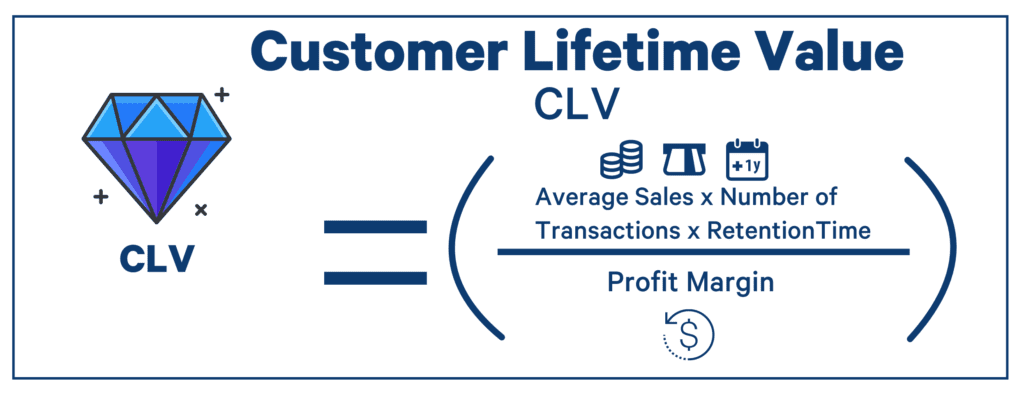
You can calculate CLV by multiplying average sales, number of transactions and retention time. Then you divide this number with your profit margin. And voilá!
Happy customers are more likely to buy from you again. Figure out why people buy from you again to make more of your customers repeat buyers.
2. Prevent and Minimize Customer Churn
This is a no-brainer: If you hear about a problem and solve it, the customers won’t leave you.
In order to recognize where these problems are, you need to constantly communicate with your customers. It’s easier to solve a problem than to win someone back over once they’ve already left you once.
The key is to let them give feedback. Offer many options to voice their opinions to gather this invaluable information.
3. Recognize Negative and Positive Word of Mouth
Wouldn’t it be nice to hear what people are saying about you behind your back? The good AND especially the bad.
The former can be used as a selling point for potential customers and the latter shows you where there’s still room for improvement.
4. Increased Revenue with Less Investment
Once your customer satisfaction measuring strategy is implemented and proven to work, you can sit back and enjoy the benefits.
It allows you to focus on improving the areas that need improvement.
While you improve, your increasingly happier customer will help you grow organically by recommending you to others. Because why wouldn’t they recommend you as they are happy?
Furthermore, they're more likely to stay as customers and keep buying.
Correlation Between Customer Satisfaction, Repurchase Intention and Customer Retention
Repurchase intention and customer retention are important topics to all, as the probability to sell to an existing customer is between 60 and 70%. As a comparison, the probability of selling anything to new customers varies between 5 and 20%.
First off, let’s define the terms.
Repurchase intention refers to a customer’s intention to buy from the same vendor again.
Customer retention refers to a company’s ability to keep their existing customers in a way that they buy from that company again. Succeeding in customer retention is one of the key factors in long-term business growth.
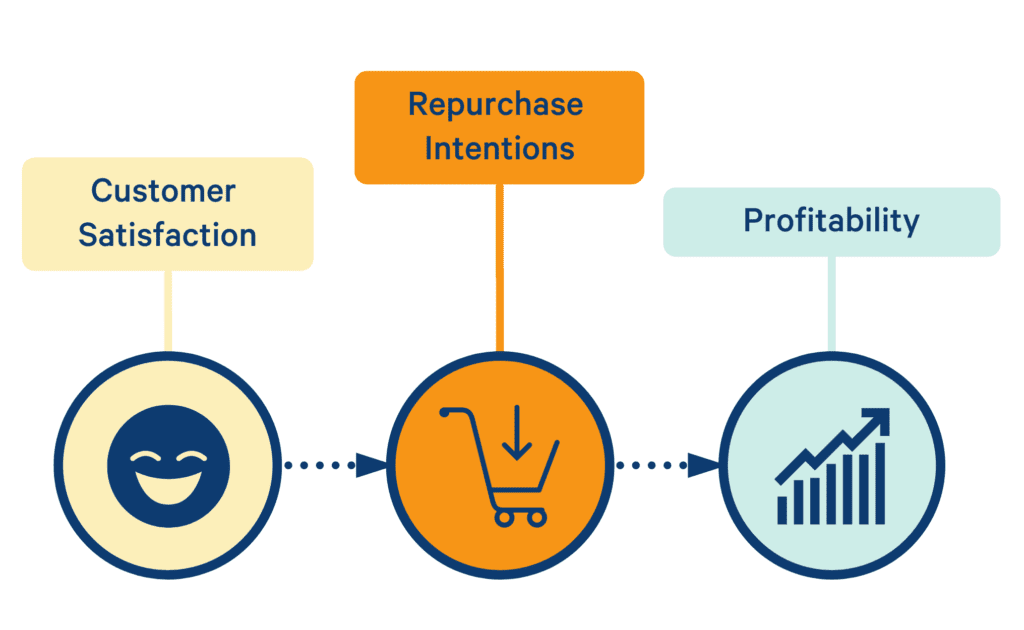
The two concepts are somewhat overlapping, but keep in mind that they aren’t just fancy words.
According to the Pareto Principle, 80% of your profits come from just 20% of customers. Furthermore, increasing your customer retention by just 5% boosts your profits by 25% to 95%.
Customer Retention's Relation to Measuring Customer Satisfaction
According to studies, totally satisfied customers’ repurchase rate is from three to up to ten times higher than that of somewhat satisfied customers. The higher your customer retention rate is, the more likely you are to thrive.
In order for you to be able to capitalize on these totally satisfied customers, you need to know who they are. That’s why you should have an actionable plan in place to collect customer feedback on all possible touch points you have with your customer focus groups.
Once you have recognized your happy customers, you can
- Showcase your cooperation by producing case studies
- Get them to write positive reviews about you
- Produce testimonials of them.
All of these help you grow organically, as your most satisfied customers become your advocates.
What’s even better is that through the feedback you get from your loyal B2B and B2C customers you are likely to develop new product ideas and services.
A win-win scenario for you and your customers.
Measuring Customer Satisfaction Helps Prevent Customer Churn
Think about the last time you had a positive customer experience. How many people did you tell about it?
Then what about when was the last time you had a bad customer service experience. How many people did you tell about that?
Negative Word of Mouth Spreads Like a Virus
In a research done by McKinsey it was stated that each unhappy customer tells on average between 9-15 people about their negative customer experience. If you think that’s a lot, you’re in for a rude awakening.
They also stated that 13% of unhappy customers tell about their experiences to OVER 20 people.
There isn’t much research done on secondary negative word of mouth and its effects, but how often have you told your friend about a bad experience your cousin’s mum’s uncle’s cat had with company X when they consider buying from them? Yup. Yieks.
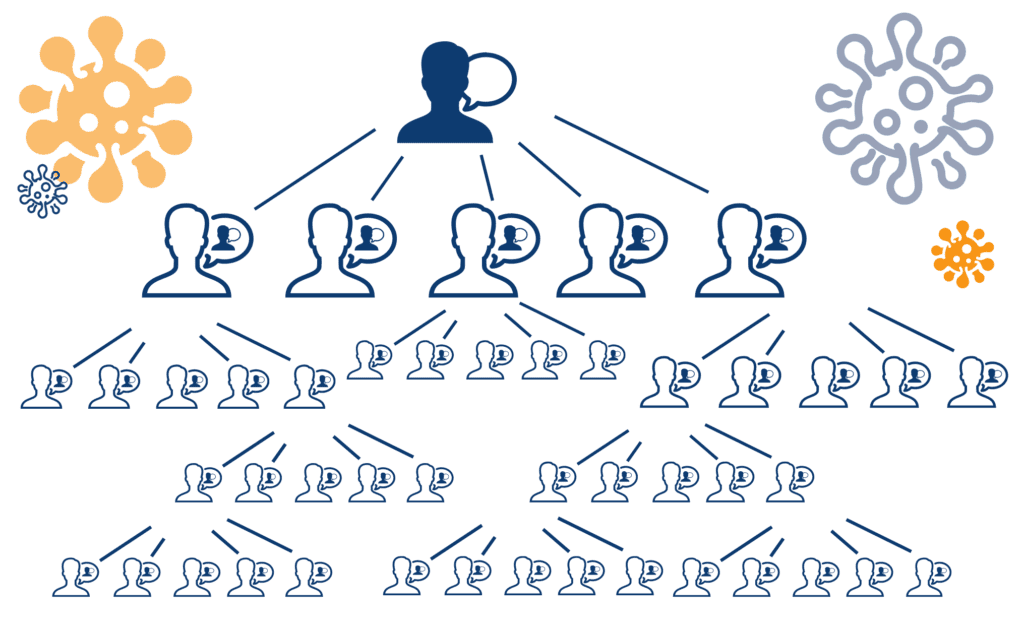
Now think about the last time your customer told you that they hadn’t received what they expected. How did you handle that? Check out our tips on how to respond to negative feedback, and guide on how to handle difficult customers.
More importantly: Are you sure you know about every bad customer experience your customers have had?
Implement an Automated Feedback System
If you don’t have an effective and automated feedback system in place, it’s more than likely that most of your customers won’t go through the trouble of giving you feedback. It’s far more likely that they’ll simply just go to one of your competitors and you’re left wondering what happened.
When we think about customer satisfaction, we often think that we should focus on doing what we do best. In reality, we should focus on listening to our unhappy customers. Doing that will help us improve.
It’s been researched that it takes 12 positive experiences to make up for a negative one.
If you get bad customer service in a café, how likely are you to ever go back there? Exactly. You won’t give them the chance to make it up, but you rather go somewhere else AND tell 10-20 people how badly you were treated.
This is a widely known issue, as even Microsoft reported already in 2018 that 61% of their respondents stopped using their products as a result of getting poor customer service.
You can’t fix what you don’t know is broken
If you aren’t measuring customer satisfaction, you are missing out on the opportunity to identify your unhappy customers. When you identify who is unhappy, you can figure out why they are unhappy, and fix the situation before they churn. If people are leaving you faster than you get new customers, you’re on your way to failure.
Step out of your bubble where you think you are the best and do everything right. Start interacting with your customers and offer them a chance to voice their opinions by systematically collecting customer feedback.
Most Used Metrics to Measure Customer Satisfaction
Now that you understand what customer satisfaction is and why it is important, you should consider the best way to measure your customer satisfaction.
Next up, there’s a break-down of the three most commonly used customer satisfaction metrics and their characteristics. After going through this list, you’ll know which one works the best for your business.
We’ll go over
First up:
1. CSAT = Customer Satisfaction Score
It literally means the percentage of your customers that are happy with your brand.
CSAT surveys ask questions, such as:
On a scale of 1 to 10,
How well did we meet your expectations today?
How would you rate the [product / service] you purchased?
CSAT surveys focus on the customer experience and the full customer journey or specifically on satisfaction of the customer support.
The benefits of measuring customer satisfaction score include:
- Turn negative reviews into positive feedback
- Improving the level of customer service
- Enhancing referral program
- Drive more sales
- Reduce churn rate
- Identify poorly performing products or services
- Inspire customer loyalty
2. NPS = Net Promoter Score
This bad boy is commonly thought of as a growth indicator. The higher your NPS is, the more likely you are to be successful.
A Net Promoter Score survey only has one question,
"How likely are you to recommend our product/services to your friend or colleague?"
It can be followed up by an optional "What is the primary reason for your score?"
Your customers are highly likely to respond, as the survey is so short. After all, it takes them at the simplest one click of a button to rate you between 1 and 10.
However, the answers you get are more informative than the CSAT score, as it gives you more (and detailed!) information about your customer satisfaction.
- How satisfied your customers are with your product/service
- Brand and customer loyalty
- Most importantly: How likely they are to recommend you to others.
How does NPS work?
Long story short: Based on the answers, your customers are divided into three categories.
The people that...
- Rated you 9-10 are your Promoters
- Rated you 7-8 are Passives
- Gave you 1-6 are Detractors
For all you visual people reading this:
Your NPS score is calculated by taking the percentage of your 9s and 10s and subtracting the percentage of people who gave you a 1-6. Your NPS score can be anything between -100 and 100.
What is a good NPS?
Anything higher than a zero. If your NPS is over 50, you’re in an excellent place and anything over 70 is exceptional. (AirBnB’s NPS is currently at 74 and Tesla’s at 96)
Then you can compare your NPS to the Fortune 500 companies. Further NPS industry averages can be found in one of our previous blog posts.
Want to know more about NPS? Check out these following blog posts for more info:
What is NPS and how do you measure it? and
How to improve Net Promoter Score? 7 Ways to Improve your NPS
3. CES = Customer Effort Score
This metric measures how much effort your customers need to put in to get their issues resolved. Whether it be a question they need answered or a technical issue they are faced with.
In layman terms: CES measures how easy (or difficult…) it's for your customers to interact with you to accomplish their goal.
Your customers will choose their answer on a scale of one to five, starting with “Strongly disagree” and ending with “Strongly agree”. CES is then calculated by summing up all customer effort scores and dividing them by the total number of respondents.
To Sum up the Customer Satisfaction Metrics
It’s worth mentioning that CES offers the least information and we recommend that you use it as a part of your customer satisfaction surveys. It is great in measuring customer loyalty, but as it is asked after each action, it can also make even loyal customers seem unsatisfied, if they’ve had one bad experience among many good ones.
Because there will be bad encounters in every partnership. The differing factor is whether they are fixed or swept under the rug and never dealt with.
CSAT, NPS and CES are somewhat complementary to each other, but they each serve a unique purpose.
When and How to Measure Customer Satisfaction
We’ve now had a look at what types of metrics there are available for measuring customer satisfaction. Then let’s move on to figuring out when and how to actually contact your customers to gather the data.
The best strategy for measuring customer satisfaction is not a one-size-fits-all approach. In many cases, a strategy that works for a B2C business won’t work for a B2B SaaS company.
Even though the principle is always the same: Ask for your customers’ opinion when they are most likely to respond, the timing of the question varies. Tremendously.
Timing, timing, timing
For instance, a bakery visitor would be confused if they were asked about the products right after entering the store (How did you like our products today?), but also would be unlikely to remember how it tasted after a few weeks (or hours!).
But most probably, they’ll give you a raving review while they’re still eating or right after it. Instagram is one good example of this: If your customer posts a story of your amazing baked goods, it’s there to see for 24 hours. Not a week or even a few days, but 24 hours.
A software user, however, will want to get the job done and not be bothered with “How do you like us at the moment?”-type of questions while doing it. They are most likely to respond after having completed whatever they wanted to have done (remember CES?).

If you want more general information, such as how likely they are to recommend you, there’s a time and way for that too.
After you have identified when to contact your customer to ask if and why they like or dislike you, you need to find the best way to reach them. Let’s first have a look at when is the right time to ask for feedback so that we can figure out how to do that in practise.
When to measure customer satisfaction?
One of the most common questions in measuring customer satisfaction is: When should I do it? The answer is simple: Everytime you want to know what your customers think.
Most companies are currently measuring customer satisfaction once a year and some quarterly with looooooooooooooong surveys that hardly anyone responds to. How many of these long surveys have you got this year alone? Whenever I see that a survey takes 5 minutes or more to do or they have many pages, I’ll skip it.
The problem with measuring too rarely is that you aren’t getting real-time data whether your customers are unhappy and about to leave you. In order to avoid this, you need to identify your key customer touchpoints.
This is how simple it should be to ensure as many responses as possible.
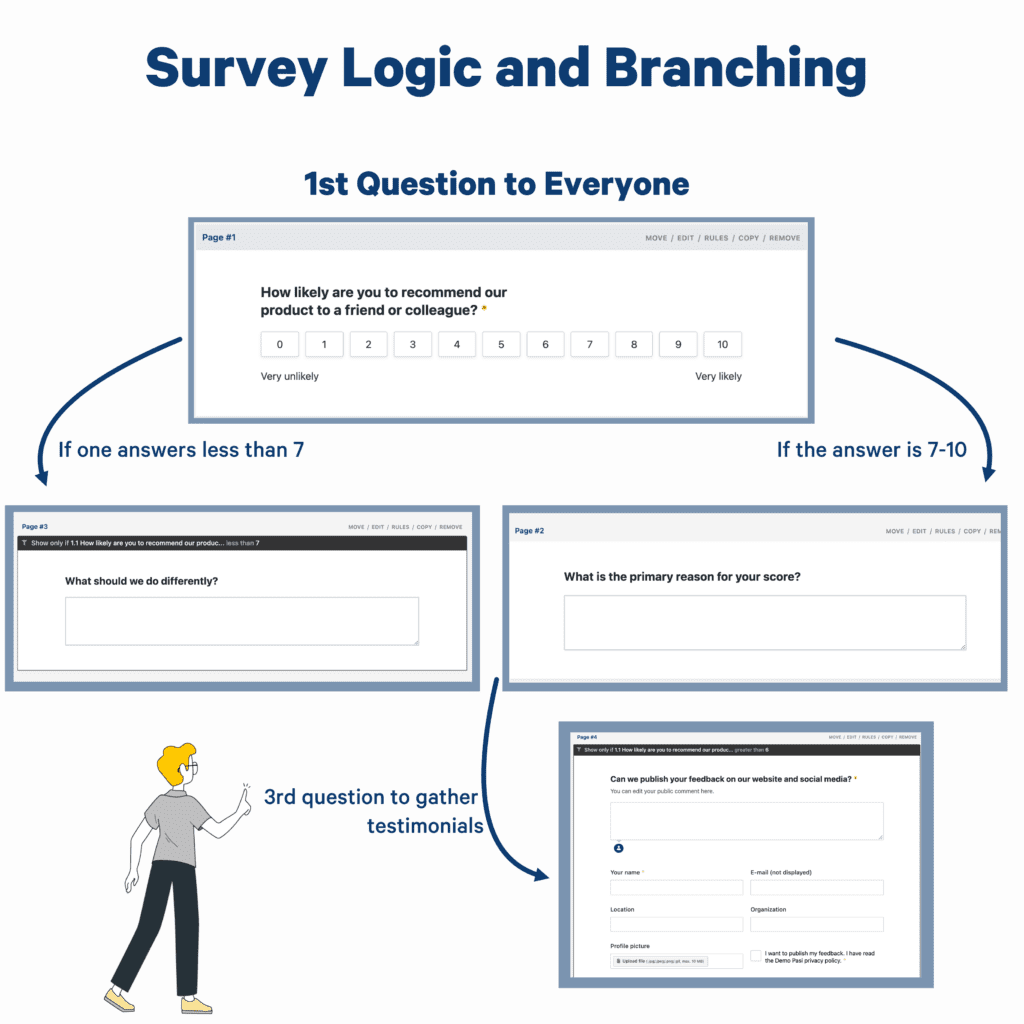
Key customer touchpoints are straightforward: They include everything from first seeing your brand, to buying your products or services and finally to the after-sales services.
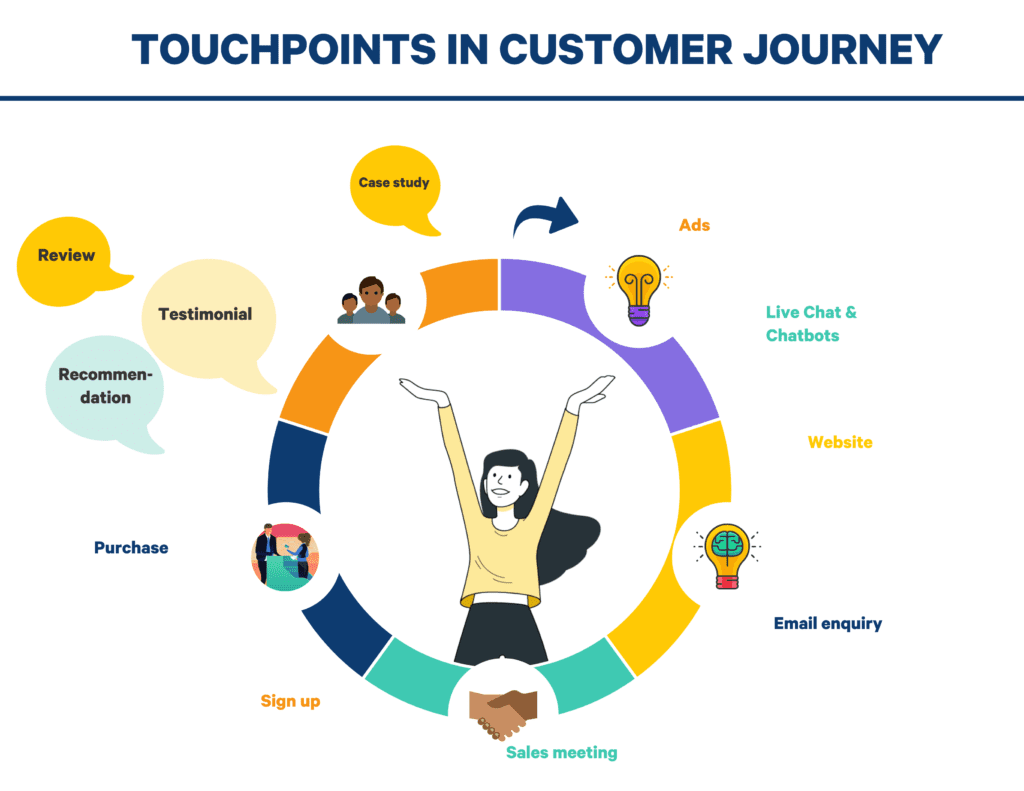
4 Key Customer Touch Points to Measure Customer Satisfaction
As customer touchpoints can be divided into three main categories: Before, during and after purchase, these are the places where you need to be with your customer satisfaction surveys.
Remember, the timing depends entirely on the nature of your business. Plus, there’s always a way to improve both your customer satisfaction and also the way you measure it. The next list will give you some food for thought regarding the timing of the customer surveys.
1. Before Purchase
As weird as it sounds, it’s important to also consider the part before someone even becomes your customer. It’s true that they aren’t your customers yet, but their opinion matters and can help you in luring in more customers in the future.
Think about the channels people get to know you before they make the first contact. These include:
- Your website
- Blog posts
- Referrals
- Social media
- Videos
- Online advertising
- Press releases
Could you add a call to action to some of these to get people to tell their opinion about the thing they just saw? “How useful was this blog post?” “Were you able to find what you were looking for on our website?” “How relatable was this referral?”
Anything! The most important thing is to get people engaged with your content as they’ll then provide you with what they think about you. This’ll also make it easier for your possible sales team to contact them, as they already have an understanding of what the customers like (and dislike).
2. During purchase
Many of us struggle with getting customers to make the final purchase decision. This is a universal issue that all companies struggle with.
The internet is filled with information and experiences about your product and you. By the way, when was the last time you actually checked what is said about you online? You should be in total control of what gets to the first page of that Google search.
You should make it easy for your customers to let you know if there’s something wrong so you can fix it and get more sales.
One of the most common scenarios of online stores is that people fill their cart, but don’t proceed to the checkout page. Oftentimes if you have filled in your email address, they’ll remind you that you still have these items in your cart. But how often do they ask why you didn’t go through with the purchase?
Have you considered what are the touch points in your customers’ purchase phase where you could ask for their feedback? These can be tricky to identify, but one way is to ask from people who didn’t complete their order and naturally the ones that did. This’ll give you something actionable to work with to increase that ROI.
A wild thought: Ask about the expectations your new customers have of you and of your service? This is invaluable data that can be used to measure how well you succeed in creating value.
3. After purchase
This is undoubtedly the most common part when it comes to measuring customer satisfaction. The timing can vary between industries, but the core idea is the same: You figure out what you are doing well and what needs to be improved.
After having bought from you once, you want to know what makes them happy and unhappy, because there is a 60-70 % chance that they’ll buy from you again in the future.
Measuring customer satisfaction after the purchase is rather straightforward. You can ask what your customers think about:
- The product or service they bought
- You in general
- Your customer service
- Your cooperation and the value you create
The list is endless, but one important thing to keep in mind is to keep the survey simple and send it as close to the experience as possible. The easiest way to do this is to fully automate this process.
4. Churning customers
Sometimes you just aren’t the right fit for the customer. It happens, as you most probably aren’t aiming to serve each and every person on this planet.
Churning customers are the best places to figure out what you should do to be able to serve this demographic in the future. Ask churning customers what made them change their minds.
Should I Send Annual Surveys to All Customers?
If you have done your groundwork right and periodically survey your customers according to your customer touchpoints, then this is not necessary.
What we mean by this is, that you should measure customer satisfaction regularly. Do this at least quarterly.
You'll know what your customers think and can see longitudinal data which shows the ups and downs of customer satisfaction.
If you want to send out more comprehensive annual surveys to your customers, try to motivate them to spend the time to speak their mind honestly. Annual surveys can serve as a way to let your customers tell everything that’s on their mind.
Rather than focusing on hearing their opinions once a year, come up with a plan to get these insights regularly, so that you can improve AND that way prevent them from turning to your competition.
At the end of the day, it’s wiser to focus on the happiness of specific target groups of your customers. This way you can better adjust your business to make them happier. If you send out the same survey to every customer, their answers might not be representative of the situation as a whole. And you’ll be left wondering what the common factor behind the dissatisfaction is.
Now that we have thought about when you should track your customer satisfaction, let's have a quick look at the different ways you can reach your customers.
7 Ways to Reach Customers to Hear Their Opinions
Even though the ways to collect feedback are different, they each have similarities in the ways you should formulate them to encourage your customers to take their time to answer you.
Keep things simple and be as personal as you can. Always remember to encourage your customers to give you feedback by telling them how important hearing their opinion is for you.
1. In store
If you’re a retailer that has a physical location, there are many ways to ask your customers about their opinion while they are there. You can print QR-codes on your receipts, place them on your table, on your menu, in fitting rooms. One way to ask for feedback is to get a terminal at the exit where people can quickly give their feedback while leaving. HappyOrNot is a great example of this. (kuvia kuvia kuvia).
2. Email
Email is nowadays one of the most used forms of collecting feedback. It is used by both B2B and B2C businesses. The contents vary from one-question NPS surveys to more extensive feedback forms. As this is one the most used methods, simplicity, timing and originality will get you far.
3. SMS
We’ve all probably received the “You just visited our store. How did you like the experience on a scale of 1 to 7?”-text message. They are an easy way of collecting numerical data, but they often lack any open ended responses, which could help you in identifying what wasn’t up to standards. They work similarly to the in-store surveys, but think about backing these up with additional ways to collect feedback so you’d get richer data to analyze.
4. Phone call
Phone calls aren’t the most convenient ways to track your customer satisfaction, as it demands a lot of resources. It can’t be scaled, but can be used as a differentiating factor when starting out your business or when you want to dig in deep on what your customers think about you.
5. Letter
When was the last time you got a hand-written letter? Or even a letter? Sending a letter to your customers asking for their feedback might be a nice way to make them feel special and to believe that you actually do care about them. You can include a short link and even a QR-code with which they can easily access your survey.
6. On website (pop-up/widget)
I’m personally glad that it has become increasingly easier to give feedback to companies. I’m the type of person who loves to give negative feedback anonymously and easily. It has become more common to have a pop-up or even a chatbot on a website which asks if I was able to find what I was looking for or if I have anything they could help me with.
7. In app (star reviews)
Many businesses have an app where the reviews can be built-in. This is a great way of collecting customer feedback in a highly automated and systemized way.
11+1 Key Questions to Ask Yourself When Choosing Feedback Collection Software
There are many factors to consider when you are first venturing into the area of measuring customer satisfaction. Here’s a helpful list of questions you should ask yourself before starting to compare different softwares with each other.
- What are my business goals for measuring customer satisfaction?
- What are the key customer touch points I should get feedback from?
- Which types of surveys can I use with this software?
- Can I personalize the surveys?
- Which processes can the software automate for me?
- How well can it be integrated into different systems I’m using?
- How much time do I need to invest in using the software in order to get results?
- What kind of analytics will it offer me?
- How easy is it to display the referrals I get?
- What kind of support do I get after purchasing the software?
- How well does the solution answer my current but also my future needs?
This is the most important and hardest to get answered.
- How can I make sure I’m getting my money’s worth?
Set your goals and do your groundwork on which software fits your needs the best.
5 Customer Satisfaction Softwares to Consider in 2022
Measuring customer satisfaction is easier when you have the right CSAT software. The following softwares will help you customize and automate your customer satisfaction measurement.
1. Trustmary
Trustmary is a specific tool that helps companies automate their customer satisfaction collection and offers insights on how to generate more leads with the gathered information. You can use ready templates to easily start gathering Net Promoter Score, CSAT and CES or create your own unique surveys.
It can be natively integrated with many CRMs, such as HubSpot and Pipedrive. Native integration means that you set the process up one time and don't have to manually do anything for it ever again. Instead, you'll get customer feedback on all the key touch points of customer journey.
2. Nicereply
With Nicereply, you can measure CSAT, CES and NPS. It’s integratable with Zendesk, Front, Pipedrive and Gmail to name a few and you get to automate customized surveys for all your touchpoints. They aim to provide their customers with the prettiest one-click surveys on the market.
3. Feedbackly
Promises to turn your customer feedback into growth by helping you attract and retain more customers with continuous measuring. They offer CSAT, CES and NPS tracking and their speciality is to offer a solution for managing your entire customer journey.
4. Smileback
Smileback is the only customer feedback system which is designed specifically for MSPs and they focus exclusively on customer satisfaction. They offer CSAT and NPS as a means of measuring. It can be used to showcase the feedback on their customers’ website.
5. Customer Thermometer
Customer Thermometer promises industry-leading response rates via email surveys. Their speciality is that surveys can be answered in the email inbox rather than by using external links. They have a fast on-boarding process.
How to Analyze Customer Satisfaction?
Once you have chosen the right software for your purposes, designed and implemented your customer satisfaction measuring tactics, you start to get a constant flow of answers.
Note: You’ll only get customer feedback regularly, if you have done all the aforementioned points right! If you don’t get feedback regularly with the set automations, they are in the wrong place/targeting the wrong people or there’s something wrong with the survey.
When you scroll through the answers the first time ever, you blush a little while reading the positives. At the same time, you wince in pain as some of your customers are rather unhappy. You are starting to realize what a mountain of work you have ahead of you to keep what’s good and improve so your clients won’t leave you.
So that you won’t feel overwhelmed about the feedback you receive, here is a guide to get started on analyzing the data.
Actionable Step by Step for Analyzing Customer Satisfaction Data
Depending on the types of surveys you have used and the industry you are in, the stages can vary greatly. This is aimed to be an all-encompassing list to help you begin analyzing – and taking action based on the results.
How many people have answered your survey?
The percentage of how many answered compared to how many customers you have is a good place to start the analysis. This percentage will tell you how generalisable your results are. Remember to sort the answers according to the predetermined customer segments (What is relevant for your business? What are your main customer groups?).
A good rule of thumb is that you need to do the groundwork well. If you find it hard to analyse your results, you’ve probably missed a step in setting your goals and figuring out your customer segments before doing and sending out the survey. But don’t worry, it’s never too late to tweak these for next time and to gain valuable insights of the results you’ve now got as well.
Start by Analysing Quantitative Data (The numbers)
Analysing the numerical data first gives you an overlook on how your business is doing. As this information isn’t ambiguous like the open-ended data, you can be more analytical. So start by analysing your customer satisfaction score.
Take a look at the NPS results you have got.
Pay close attention to the number of promoters (9-10), passives (7-8) and detractors (1-6) your company has. Interestingly, the number of passives seems to be one of the most crucial factors to track, as they are the most likely to churn in a B2B annually billable software and services context.
Take a look at the numeric data you have collected with CES
- The higher the number is, the easier it is for your customers to interact with you and get the job done.
- Take a look at the CSAT score you got. An outstanding CSAT score is 80%, but it varies with each industry.
- Compare your results with your industry’s benchmark (And with your competitors!) by Googling “enter industry here” CSAT benchmark → realtors CSAT benchmark
Source: Nicereply
Take a look at the qualitative data (=what people have written to the open-ended parts)
- Pay special attention to what the passives in each customer segment have said about you and act on it immediately (or at least very soon). This group is easier to convey to stay than detractors.
- Going through the qualitative data offers you great insight into what your customers value and what they wish was done differently. This data will help you understand the motivations behind their purchasing decisions and the reasons why they are unhappy.
- Divide the positive and negative feedback into their own groups.
Look for Trends
After you've analyzed all quantitative and qualitative data, it's time to look for recurring trends.
Look at your data as a whole, but then segment your customer satisfaction data based on your buyer personas or ideal customer profiles.
Here are some questions that help you in getting the big picture.
- What are the most commonly mentioned aspects?
- Are some of the comments mentioned across the whole data?
- What is the most surprising thing to come up?
- What did you expect to come up, but didn’t?
- What kind of comments have the customers with the highest lifetime value left you?
- What are the areas of improvement?
What to Do With the Analyzed Customer Feedback Data?
Now that you have the data you wanted, it’s time to act on it.
Not sure where to start? Go over this practical list and you’ll be able to make better business decisions based on the analysed data.
Fix what’s broken
Don’t disregard the customer’s opinion, but aim to change the things they don’t like. And do it NOW before they leave you for someone better.
Present Data to Relative Managers within Organization
Your Sales Managers, Marketing Team, Growth Hackers and Customer Success Managers need different data and in different forms.
This means that you need to take the data to them in a bite-size format and go over what that means currently for them and their work. You need to give each team concrete goals for the future and to help them figure out what they need to do in order for the metrics to look different next time.
Make Customer Centricity a Norm and Prioritize Customer Success
In order to stay on the pulse of what each of your customer feels, you need to constantly measure their satisfaction levels. If someone gave you a positive review a month ago, they might feel differently now.
Remember those goals you set with your managers? Once you have got more data with the current customer satisfaction scores, go over the changes with the managers. Help them see how their everyday actions help in improving customer satisfaction.
Analyze Changes Over Time
Once you’ve collected data for months you’ll start to see certain trends. Once you continue the process for years you get a detailed picture of how you did in June 2020 vs how you did in June 2021. It’s not just important to compare the current month with the previous, but also what the situation looked like a year or five years ago.
Measuring satisfaction systematically over a long period of time will offer you insights of your company you couldn’t previously have even dreamt about.
It’ll help you in figuring out what’s wrong with your business and also to see what actions have actually made a difference.
Causation vs. Correlation
Focus more on chain effects than if x than y- scenarios. Tracking your customer satisfaction is a long-term process, not a sprint. Its needs and practices change, develop and grow at the same time with your business. One thing is sure: Improving customer satisfaction will lead to tangible benefits.
Engage your Whole Company
Getting positive feedback is important for us all. We want to feel that our work matters and we all need to hear what we’re doing well. It’s a great way to boost morale within the organization, if you automatically inform all employees with automated workspace integrations when a client has given a positive review.
That way others can see even the work quiet people have done and can make doing well a common priority.
It’s a positive experience for each employee to be thanked and hyped both by their own managers and colleagues. The example below illustrates this perfectly. (As the person giving the feedback didn’t allow us to use this feedback as a public referral with his name on it, the name of the customer and the company they work for are blanked from this picture. They did leave their name for us to see.
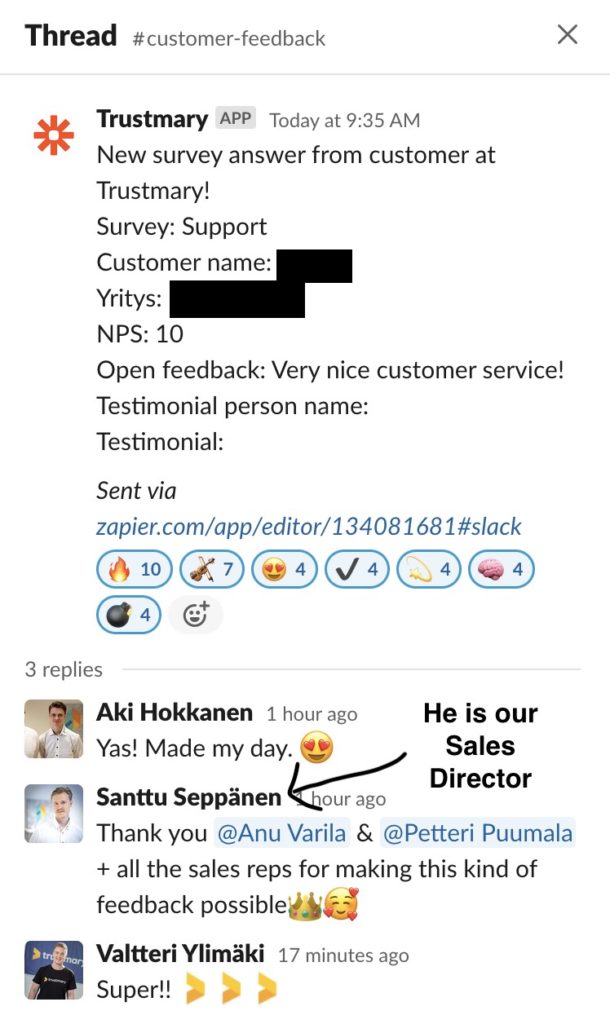
When your employees feel good it will inevitably improve customer satisfaction. It creates a positive cycle where everyone feels good and your customers get excellent customer service.
Happy employees → Happy customers → Happy business
By the way, when was the last time you measured employee satisfaction?
Trustmary has great employee satisfaction question templates to try!
Is Customer Satisfaction Still Important in 2024?
The short answer is, yes. We've also written about the best practices for doing customer satisfaction surveys in 2024.
The longer answer is: Customer satisfaction will be crucial to all businesses in the future. Simply, because measuring and improving your customer satisfaction is a crucial factor in building relationships with customers and making them stick around.
Many companies have made the mistake of thinking they know what their customers think, need and want. Even if they ask about that once a year. We all claim to be the best in our field, but can you honestly say that you can talk the talk AND walk the walk?
The American Customer Satisfaction Index (ACSI LLC) is doing a great job in measuring the satisfaction of consumers across the US economy, but they only interview around 350.000 customers annually, so it certainly has its limitations.
Take your future business success into your own hands and make sure you ARE staying updated on your customers’ current thoughts.
And not once a year, but rather change your mindset on collecting customer feedback and start to collect data now. Every single day.
You can thank me later.
Simple Step-By-Step List to Start Collecting Customer Satisfaction Data
In case you are wondering, what you should do to get started NOW.
Don’t worry. I got you. Just follow this list and you’ll succeed:
- Identify your different customer segments
- Set your goals for collecting feedback
- Try Trustmary to get feedback within minutes from sending the survey
- Create a survey from the Trustmary template library
- Upload client contact information list (excel/sheets) OR connect directly to your CRM
- Send survey
- Analyze the results
- Improve and grow your business faster
